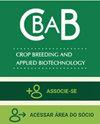Callus induction and pro-embryogenic mass formation in Myrciaria dubia , an important medicinal and nutritional plant
IF 1.1
4区 农林科学
Q2 Agricultural and Biological Sciences
引用次数: 2
Abstract
Abstract: Cacari is a fruit tree that is native to the Amazon region of Brazil. The fruit is considered to have the highest vitamin C content of any edible fruit (13.757 mg 100 g-1 dry weight). The objective of this study was to evaluate the effects of 2,4-D and 6-BAP alone or in combination on in vitro callus induction and pro-embryogenic mass formation in cacari stem segments in different culture media as a precursor for cacari micropropagation. The experiment consisted of two culture media (MS and WPM) and combinations of four concentrations of 2,4-D (0, 1, 2 and 4 mg L-1) and BAP (0, 0.25, 0.5 and 1 mg L-1). The results showed that the highest percentage of callus formation (99%) was obtained in WPM supplemented with 4 mg L-1, 2,4-D and 1 mg L-1 BAP, and this combination resulted in 93% pro-embryogenic mass formation.重要药用营养植物杜比杨梅愈伤组织的诱导和胚性物质的形成
摘要:仙人掌是原产于巴西亚马逊地区的一种果树。这种水果被认为是所有可食用水果中维生素C含量最高的(13.757 mg 100 g-1干重)。本研究的目的是评估2,4-D和6-BAP单独或联合使用对不同培养基中仙人掌茎段的体外愈伤组织诱导和原胚性物质形成的影响,作为仙人掌微繁殖的前体。实验由两种培养基(MS和WPM)和四种浓度的2,4-D(0、1、2和4mg L-1)和BAP(0、0.25、0.5和1mg L-1)的组合组成。结果表明,在添加4mg L-1、2,4-D和1mg L-1 BAP的WPM中,愈伤组织的形成率最高(99%),并且这种组合导致93%的胚性前体形成。
本文章由计算机程序翻译,如有差异,请以英文原文为准。
求助全文
约1分钟内获得全文
求助全文
来源期刊
CiteScore
2.40
自引率
13.30%
发文量
25
审稿时长
6-12 weeks
期刊介绍:
The CBAB – CROP BREEDING AND APPLIED BIOTECHNOLOGY (ISSN 1984-7033) – is the official quarterly journal of the Brazilian Society of Plant Breeding, abbreviated CROP BREED APPL BIOTECHNOL.
It publishes original scientific articles, which contribute to the scientific and technological development of plant breeding and agriculture. Articles should be to do with basic and applied research on improvement of perennial and annual plants, within the fields of genetics, conservation of germplasm, biotechnology, genomics, cytogenetics, experimental statistics, seeds, food quality, biotic and abiotic stress, and correlated areas. The article must be unpublished. Simultaneous submitting to another periodical is ruled out. Authors are held solely responsible for the opinions and ideas expressed, which do not necessarily reflect the view of the Editorial board. However, the Editorial board reserves the right to suggest or ask for any modifications required. The journal adopts the Ithenticate software for identification of plagiarism. Complete or partial reproduction of articles is permitted, provided the source is cited. All content of the journal, except where identified, is licensed under a Creative Commons attribution-type BY. All articles are published free of charge. This is an open access journal.

 求助内容:
求助内容: 应助结果提醒方式:
应助结果提醒方式:


